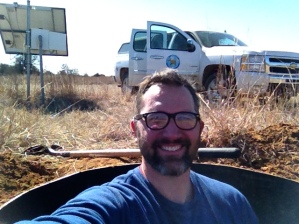By Isaac Woelfel
There is a good chance if you live in rural northwest Oklahoma you have seen me this past week driving a white Chevy Silverado with the Oklahoma Geological Survey emblem.

I might have even pulled into your driveway and knocked on your front door to inquire as to whether you, as a landowner, would be interested in assisting the OGS with seismic research by allowing us to install a permanent station. It can be a tough sell, as all sites are volunteered with no financial benefit to the landowner, but it is exciting when a landowner understands they have an opportunity to help the state better understand earthquakes in their region.
As a Seismic Technician, a part of my responsibilities in maintaining the OGS’s seismic network is siting and installing new seismic stations. Due to the recent increase in earthquakes, there is a need to expand the permanent seismic network in northwestern Oklahoma in order to collect better data for earthquake locations and magnitude calculations.
As I have stopped and petitioned individuals — from on their front door step to introducing myself to landowners enjoying coffee in service station cafes — the most common questions have been:
- What would you be installing on my land?
Using a 6×6 foot plot of land, the equipment consists of a small seismometer placed underground in a vault constructed from a rain barrel with a small amount of concrete at its base, and an above ground equipment box, 2x3x2 feet, to house the data logger, power converter, back-up battery, and solar panel, both mounted on a pole.
- Where do you want to put it?
The answer as to “where?” is as far out of the way as possible, yet accessible. As I seek out potential sites, I am looking for areas that have low seismic noise, ground motion that is recorded but is not related to what research scientists are investigating (i.e. not an earthquake).

Seismic noise can be natural, powerful winds and running water, or it can be cultural, vehicles or trains passing close by. So, I make sure that the site is 5 miles away from railroad tracks and from highway or heavily trafficked roads, and 1 mile away from rivers and streams. Once I have met with a willing landowner who has land that meets the criteria previously mentioned, I figure out if they have an appropriate area to install the station. The criteria being: clear south facing exposure for the solar panel, low to no visibility from the road, placed on a ridge or high ground, placed along a fence line to keep the station out of the way of landowner activities, and whether the station will need to be fenced to deter field animals.
- How often will you be visiting the station?
If everything goes according to plan, we will only need access to the station a few times a year to conduct routine maintenance, but occasionally a station will unexpectedly go down and we will need access for repairs. The landowner is contacted before each visit, unless it is specified that it is not necessary.
As I am siting, I can honestly say that I am never just passing through. There is too much to take in on drives across the state, and it sounds cliché to say that not enough credit is given to Oklahoma’s natural beauty, but it’s true. From its plains, mesas, mountains, and lakes and rivers, it never fails to inspire. Siting has also been a great way to interact with its residents who come from all walks of life, especially those who have taken an interest in Oklahoma’s seismicity.
See you out there, Oklahoma!








you may put one on my land
LikeLike
Hi, Sue. Please email us some details on your land. If it fits our site criteria, we just might do as you suggested.
LikeLike